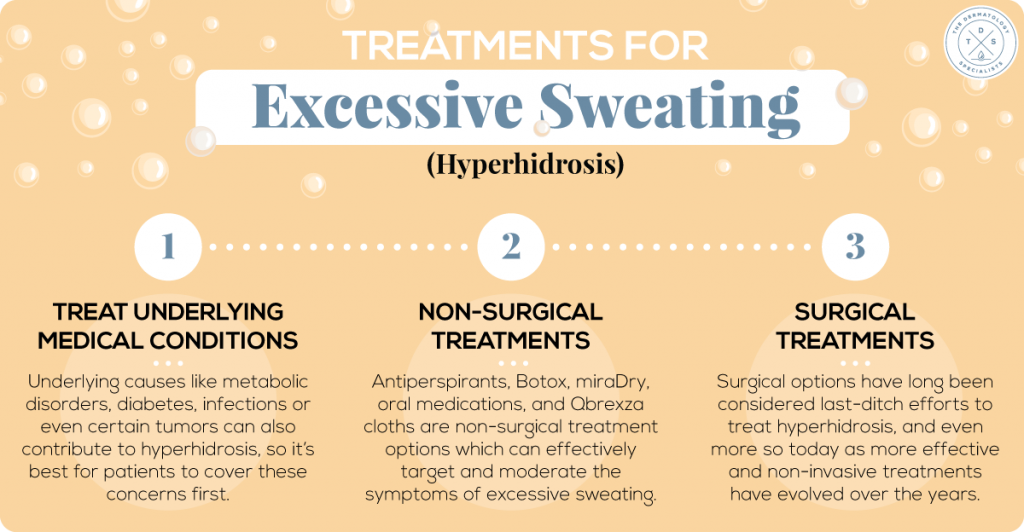 Sweating is a natural and necessary function of the human body. Whether you’re physically active at the gym or enduring the hot summer weather, sweating is as natural as going to the bathroom.
Sweating is a natural and necessary function of the human body. Whether you’re physically active at the gym or enduring the hot summer weather, sweating is as natural as going to the bathroom.
However, for nearly 7.8 million people in the United States who suffer from hyperhidrosis, known more commonly as excessive sweating, it can become an extreme physical burden that frequently causes emotional hardships, embarrassment and social stigmas.
Hyperhidrosis is a medical condition characterized by abnormal and excessive sweating throughout the body or in localized areas like the underarms, groin, hands or feet.
What is the difference between normal and excessive sweating? What causes it? And how can we treat it? We spoke with Dr. Sourab Choudhury, board-certified dermatologist and the Chief Medical Officer of The Dermatology Specialists, to find out more.
Everyone naturally sweats. We perspire to regulate body temperature and guard against overheating. Therefore, it’s common to sweat during strenuous physical activity, in hot weather or as a reaction to stress. While the average amount of sweat varies for each individual, sweating profusely under these circumstances is entirely normal.
On the other hand, sweating in cooler temperatures or during sedentary activities — like working at a desk — indicates you may have hyperhidrosis.
“When people find themselves constantly perspiring in unexpected situations — even when it’s not due to physical exertion or extreme weather — then it’s time to see a doctor,” says Dr. Sourab Choudhury.
Excessive sweating in these uncommon situations can stain clothes and make day-to-day life more challenging. Severe cases of hand sweating, for example, can even make practical situations like holding a pen, gripping a steering wheel or shaking hands extremely difficult. Of course, the social implications of hyperhidrosis can be drastic as well, ranging from depression to social anxiety.
The reason one patient experiences hyperhidrosis can vary drastically from another. Excessive sweating can be triggered by underlying health conditions, medication side effects, anxiety, and sometimes, just unlucky genetics. Excessive sweating due to genetic factors is called primary hyperhidrosis, while the condition triggered by underlying factors (medication or health conditions, e.g.) is called secondary hyperhidrosis.
“Thyroid disease is a common underlying factor, but certain medications like antidepressants can also cause hyperhidrosis. In other cases, changes in hormones, like menopause, and lifestyle changes that cause severe anxiety can also trigger excessive sweating,” explains Dr. Choudhury.
Underlying causes like metabolic disorders, diabetes, infections or even certain tumors can also contribute to hyperhidrosis, so it’s best for patients to cover these concerns with their primary care providers. It’s typically better to address the underlying factors before treating the hyperhidrosis itself.
While excessive sweating doesn’t often cause serious health complications, the condition is often uncomfortable and is closely linked with anxiety and depression. It’s therefore a good idea for patients to address any concerns of excessive sweating, especially if it’s impacting their quality of life.

After a patient sees a medical doctor to rule out secondary hyperhidrosis, the next step is to consult with a dermatologist. With some trial and error, a personalized treatment plan can properly manage and mitigate hyperhidrosis symptoms.
According to Dr. Choudhury, the first attempt at treatment is usually a trial of an over-the-counter antiperspirant.
“While deodorants help with the smell under the arms, antiperspirants can actually decrease the amount of sweating someone experiences. While most people think of using antiperspirants under the armpits, we also see success on other areas, like the hands and feet,” explains Dr. Choudhury.
If antiperspirants are working but not producing strong enough results, the next step is to consider a prescription-based antiperspirant which has higher amounts of aluminum chloride that block the receptors which stimulate overactive sweat glands.
If antiperspirants don’t work at all, there are several other treatment options available, depending on where the hyperhidrosis occurs on the body. While surgical options are always a last resort, non-surgical treatments have come a long way over the last two decades. We now have several treatment options available to effectively target and moderate the symptoms of excessive sweating.
Available as a treatment option since 2004, research shows BOTOX injections are now 80 to 87 percent effective in decreasing overactive sweat glands. The treatment works by paralyzing the muscles that surround the sweat glands. Patients generally like this treatment because it takes only 15 minutes with additional injections needed every four to six months. Although injections may be uncomfortable for some patients, they’re usually well-tolerated with little to no side effects.
Since 2011, miraDry laser therapy has become one of the most innovative treatments for hyperhidrosis of the underarms. A dermatologist uses a small, non-invasive device with thermal energy to make a permanent reduction in overactive sweat glands. After targeting the underarms, the procedure allows for a more even distribution of sweat throughout the patients’ body. Research shows that miraDry significantly reduces excessive sweating in 90 percent of patients who undergo the procedure.
Although miraDry takes longer than a BOTOX procedure — about an hour — patients usually only need one or two procedures for permanent effects. There is often some level of swelling and discomfort directly after surgery, so it can take up to 1-2 weeks to fully recover. However, 90 percent of patients report an overall satisfaction rate with this procedure. Since it is so effective on the underarms, miraDry is looking into treating excessive sweating in other areas of the body too.
In addition to antiperspirants, dermatologists often prescribe oral medications to treat generalized and facial sweating. Commonly prescribed medications include glycopyrronium (Robinul), benztropine and oxybutynin, which help to block chemical receptors that stimulate hyperhidrosis. When these medications are consumed at an effective dosage, the downside is that most patients experience side effects like dry mouth, constipation, blurred vision and heart palpitations.
As the newest innovation in hyperhidrosis treatment, Qbrezxa cloths are medicated wipes that help to block the receptors that cause excessive underarm sweat. A convenient, easy-to-use option for patients, they only need to apply one wipe to both underarms once daily.
The active ingredient in Qbrexza, glycopyrronium, is offered as an oral medication to reduce hyperhidrosis symptoms (see above). It can have similar side effects when used as a medicinal wipe, although they are more rare. It should be noted, however, that topical treatments sometimes cause additional side effects like redness, burning or itching.
That said, research from the International Hyperhidrosis Society reports that when Qbrexza wipes are used daily for four weeks, the severity of excess sweating decreases by 25 to 30 percent with a 50 percent decrease in overall sweat volume. Studies also indicate that Qbrexza is even effective and safe for children as young as 9 years old.
Qbrexza’s side effects are one downside, while another is the frequency and consistency required.
“A drawback of Qbrexza treatments is that these wipes must be used daily, so they’re not as long-lasting as BOTOX injections or miraDry treatments. Fortunately, insurance companies sometimes cover the product’s cost, which can help to offset the inconvenience of the high-cost treatment,” says Dr. Choudhury.
Surgical options have long been considered last-ditch efforts to treat hyperhidrosis, and even more so today as more effective and non-invasive treatments have evolved over the years.
However, when non-surgical treatments prove ineffective, liposuction can help to remove sweat glands and reduce symptoms of excess sweat in targeted areas. Sweat glands are notoriously difficult to see, so the effectiveness of this procedure can vary from person to person, and procedure to procedure.
“Although liposuction procedures are completed under local anesthesia in a dermatology office, the treatment is invasive and the results are sometimes inconsistent. We usually recommend trialing non-invasive options first and using surgical options as a last resort,” explains Dr. Choudhury.
Endoscopic thoracic sympathectomy (ETS) is another last-ditch surgical option, one which involves doctors cutting the nerve signals that stimulate overactive sweat glands. A tiny camera is inserted underneath the underarms or hands while the surgeon cuts along the nerve paths to permanently shut off the signal responses. The surgery comes with a risk of side effects like irreversible compensatory sweating throughout the body, hypertension and heat intolerance.
If excessive sweating is impacting your quality of life, it’s probably time to see your doctor. The good news is that hyperhidrosis is treatable. The condition is frustrating and, at times, emotionally draining, but knowing that you have innovative treatment options available can be a huge relief. Hyperhidrosis patients today can wipe away their sweat — and the emotional burdens that come with it — more effectively than ever before.
 Sourab Choudhury is a board-certified dermatologist and the Chief Medical Officer at The Dermatology Specialists (TDS). He is affiliated with both Mount Sinai Medical Center and St John’s where he has taught residents for nearly a decade. Having practiced dermatology for over 20 years, Dr. Choudhury has become known for his world-class expertise and compassionate care.
Sourab Choudhury is a board-certified dermatologist and the Chief Medical Officer at The Dermatology Specialists (TDS). He is affiliated with both Mount Sinai Medical Center and St John’s where he has taught residents for nearly a decade. Having practiced dermatology for over 20 years, Dr. Choudhury has become known for his world-class expertise and compassionate care.